How to Make Easy Peel Soft Boiled Eggs
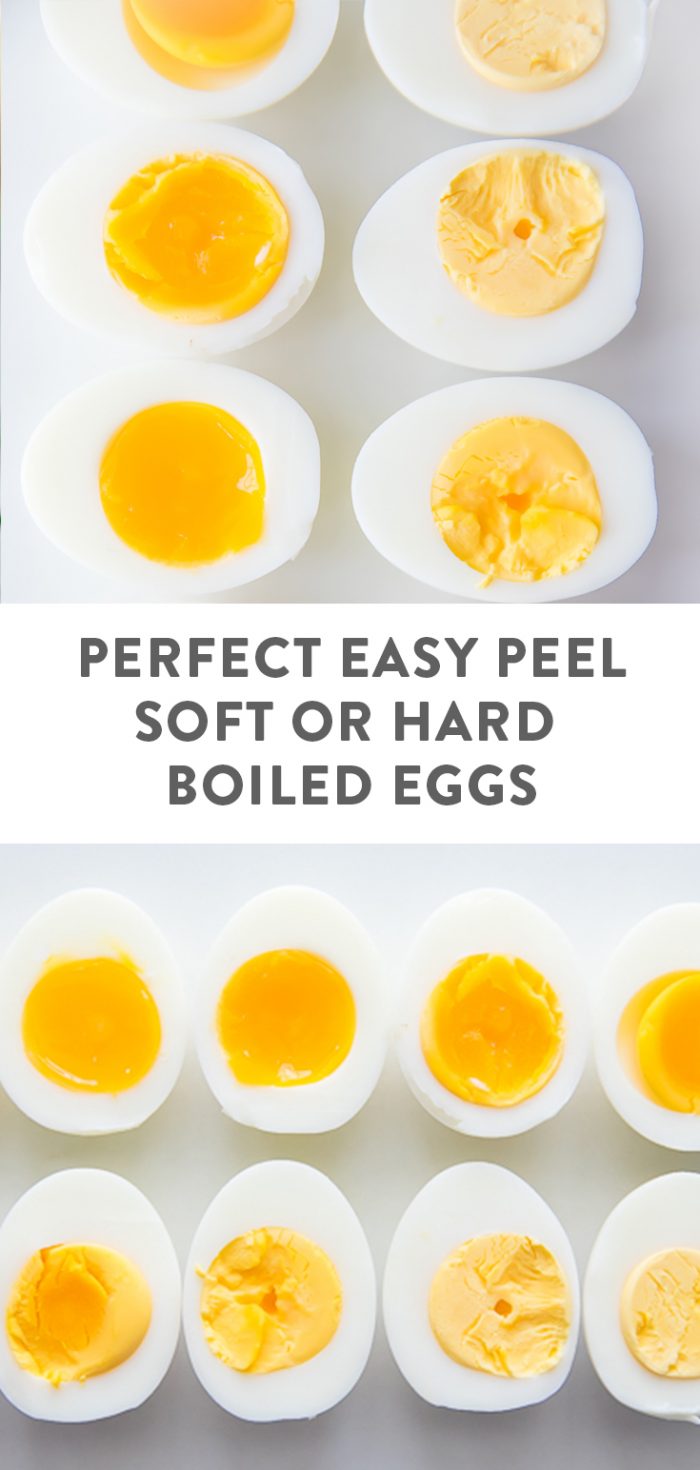
This super simple method creates the most perfect boiled eggs that are so easy to peel. From soft boiled to creamy hard boiled, this article is all you need for perfect boiled eggs every time. Ideal for deviled eggs and Easter eggs.
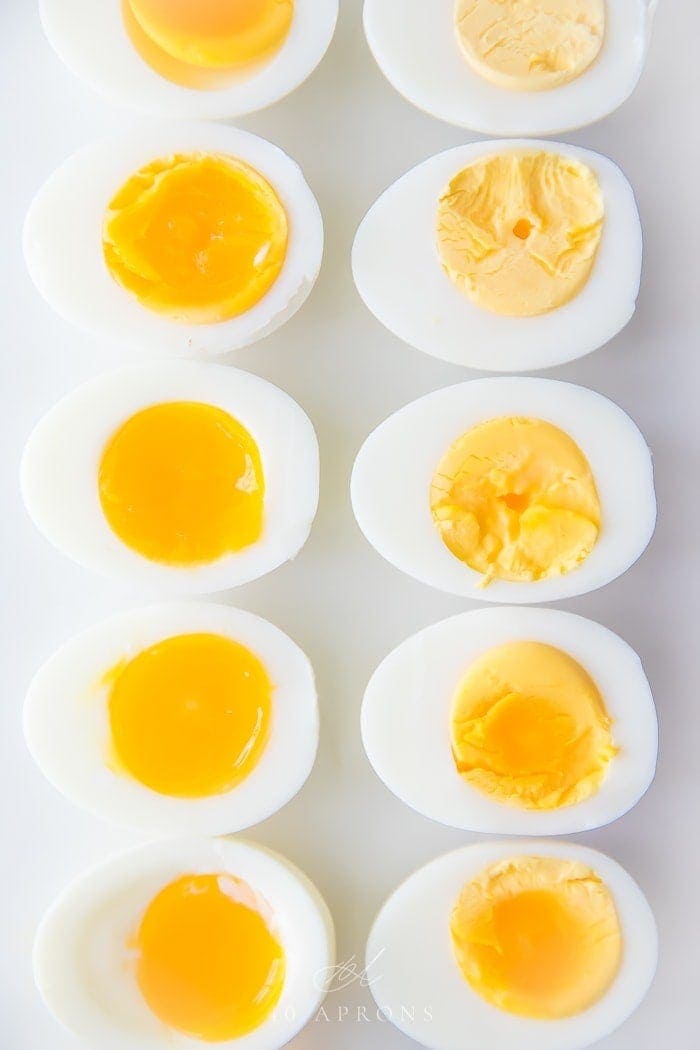
I have to confess something…
I couldn't boil eggs for years.Decades. Like, I was married and would buy hard-boiled eggs at the store, because I could never get them to peel easily. Or at all. I'm talking eggs that look lunar, like they've been beat to pieces with asteroids over millions of years!
Not pretty.
I was doing itall wrong, and, don't hate me, but you probably are, too.
I used to start the eggs in cold water and bring them to a boil. I also tried adding the eggs to boiling water and then removing them from the head and letting them just steep for however many minutes.
And it never worked just right. Peeling them was an absolute pain, and the creaminess and doneness of the yolks always, always varied.
Then I discovered this insanely simple method that's so perfect it should be illegal! Or universally known. You know… one of the two. I'm lobbying for the second option, because, y'all.
Why This Method Is Absolutely Perfect
- Not only is this method for perfect boiled eggs crazy easy and quick, but…
- They're the easiest boiled eggs I've ever peeled.
- It produces the richest, creamiest yolks, whether you want liquid yolks, jammy yellows, or fully solid centers.
- The yolks never turns blue-green or sulphuric.
- You can peel a dozen in about 2 minutes!
- No need to fuss over old vs. new eggs; it all works just as well!
Let's get right down to it!
How To Do It
There are a couple important steps to this method for perfect hard and soft boiled eggs that are a cinch to peel.
Fill a saucepan with water, making sure there's enough water in the pan to cover the eggs. Add a big pinch of salt and a splash of vinegar – it doesn't really matter what kind!
Place the saucepan on the stove and bring to a boil.
Very gently, lower the eggs into the boiling water, taking care to lower them all the way to the bottom of the pan before releasing. Doing this will prevent cracking, so make sure it's as gentle as possible. I like to use a small, handheld mesh strainer to do this, then I use it later to transfer the eggs to the ice bath.
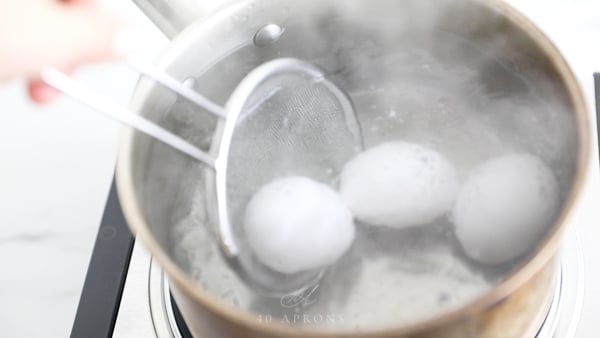
Start a timer as soon as the eggs enter the water. Boil the eggs as long as you'd like to produce the desired result. I like:
- 5 minutes for a super runny yolk
- 7 minutes for a gorgeous, jammy yolk. My favorite!
- 12 minutes for the perfect hard-boiled egg.
See below for a visual guide for how long to cook perfect easy to peel boiled eggs.
While eggs are boiling, prepare an ice bath that will hold all eggs. I like to go heavy on the ice here, as the hot eggs will melt some upon entering the ice bath and will create enough water.
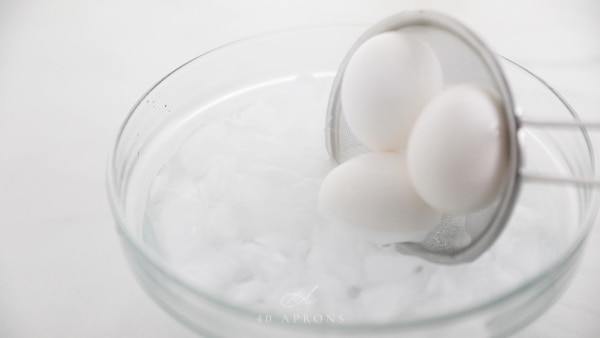
After boiling for the desired amount of time, transfer eggs to an ice bath. Either quickly pour out the water from the saucepan and scoop the eggs into the ice bath, or simply remove the eggs using a slotted spoon or small handheld strainer.
Let eggs sit in the ice bath until cooled, about 5 minutes. Drain the eggs from the ice bath and return to a bowl.
Aggressively jiggle the pan and toss the eggs up about half an inch, banging them against the sides of the bowl and each other. You want the shells to really crack and become almost like mesh or a mosaic; this makes them exceedingly easy to peel.
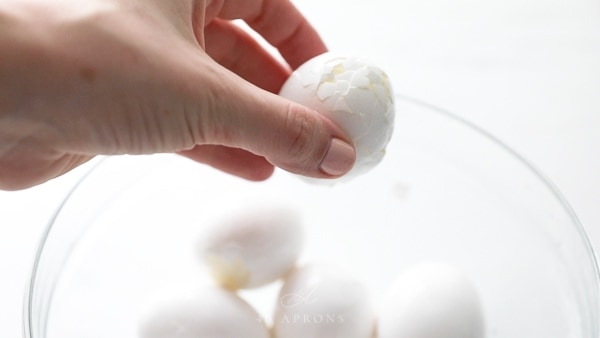
Once shells are well cracked, peel under running water. You don't need the water to peel the eggs, but it makes it much easier to flush away the tiny pieces of shell that stay attached to the egg.
Prepared Water Bath vs. Filling the Saucepan with Ice
Ideally, you'll transfer your boiled eggs directly to a prepared ice bath.
But let's face it, it can be easier to drain the hot water from the eggs and fill it up with cold water and ice. That's how I used to make my perfect boiled eggs, and they were truly perfect! I find that transferring them to a prepared ice bath makes themeven easier to peel, but you can follow this method, too:
- After eggs are finished boiling, immediately and carefully drain the hot water then almost cover eggs with cold water.
- Add plenty of ice, about 2-3 cups. Let sit until chilled, about 5 minutes.
- Drain cold water then shake and jiggle pan aggressively, tossing the eggs up a little bit to really crack their shells.
- Peel under running water.
How long does it take to boil an egg?
Well, let's experiment, shall we?
I boiled each egg with exactly the same method (Lower into boiling water, boil forhowever many minutes, then transfer to an ice bath), for a different amount of time. Here's how they look:

- 4 minutes: Mostly set white that doesn't stay together. Super liquid yolk.
- 5 minutes: Almost entirely set white with a runny, nearly liquid yolk.
- 6 minutes: Set white and creamy, gooey yolk. Great for ramen and similar dishes.
- 7 minutes: Firm white and jammy yolks. Great for eating alone, topped with your preferred seasoning and a nice pinch of salt. My favorite!
- All eggs from this point on have firm whites.
- 8 minutes: Half-set yolk. The edge is solid and creamy but the center is soft and almost a little jammy.
- 9 minutes: Mostly set yolk, but the center is quite moist.
- 10 minutes: The yolk is half fully set (light yellow) but the center half is still darker yellow and moist.
- 11 minutes: The yolk is mostly fully set (light yellow), but not quite. The very center is still a little moister than the rest.
- 12 minutes: The yolk is fully set and light yellow but still super creamy.
- 13 minutes: Fully set but less creamy.
- 14 minutes: Fully set but starting to get dry.
Types of Eggs
Old vs. New Eggs
I found only a very slight difference between peeling old and new boiled eggs. I compared "brand new, purchased yesterday" eggs with eggs that were purchased at least a week before. Compare the two left eggs in the below graphic.
That said, the remaining eggs used for this article were new, conventional eggs. I had zero problems with them whatsoever. I wouldn't worry too much about which eggs you use to boil, though hard or soft boiled eggs would be a great way to use up those eggs you've had in the fridge a week or two!
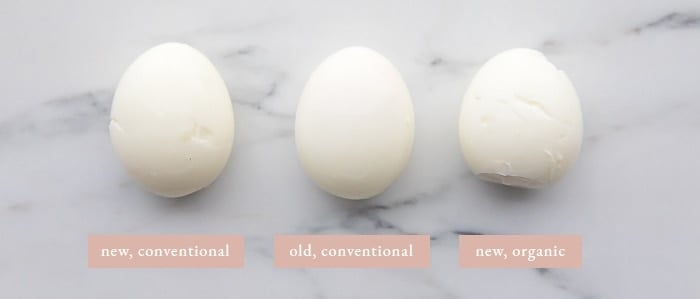
Conventional vs. Organic Eggs
I did find a significant difference between conventional and organic eggs. The conventional eggs were extremely easy to peel, while the organic werevery easy to peel. It did not make enough difference to dissuade me from continuing to use organic eggs for my perfect easy peel hard and soft boiled eggs.
My advice is to make sure to add a glug of vinegar to the boiling water when boiling organic eggs, and, if you can, opt for older eggs, rather than that fresh dozen in your fridge.
How to Make Them
There are four easy elements to this method that make these soft and hard boiled eggs so easy to peel, and there's only one element you can skip.
- Lower the eggs into boiling water and cook them in boiling water . Do not bring the water to a boil with the eggs in the pan, and do not add the eggs to boiling water, remove from heat, and let stand in hot water.
- Immediately after cooking the desired amount of time, remove eggs from hot water and transfer to an ice bath . Let stand in the ice bath until chilled, about 5 minutes or so.
- Add a splash of vinegar and salt to your wate r. The vinegar helps make the eggs easier to peel, and the salt helps seal any cracks by coagulating the egg. This is the only element you can skip!
- After the ice bath, drain and jiggle your boiled eggs around in a pan or bowl pretty violently , shaking the bowl or pan and tossing them up a 1/2-1″ or so. Do this until the shells are cracked all over, almost like mesh. You can peel them under running water to help flush away any small bits of shell left over, but it is not necessary for making these boiled eggs easy to peel.
Vinegar and Salt in the Water
I'll keep it simple: you should add vinegar and salt to your boiling water. Here's why:
- Adding a glug of vinegar to the boiling water makes the eggs easier to peel.
- Add salt to your water makes the eggs coagulate in case of cracks, preventing much leakage. You know, those ribbons of egg whites that appear, even though you thought you were so careful!
It doesn't really matter what kind of vinegar you use, but add about 1-2 tablespoons to your water as it heats. Include a big few pinches of salt at the same time.

Use the Membrane
If you're so lucky as to have pieces of your shell attached to a membrane that's still intact, work with it! The white, thin membrane in between the boiled egg and the shell is a layer that can help you quickly and easily slip off the shell entirely. Try to work a finger below the membrane to pull the shell off or push the membrane with the shell around to remove the shell as a whole. It's a little hard to explain, but when you see it, you'll know!
How to Use Hard and Soft Boiled Eggs
There are so many uses for this recipe! Beyond enjoying plain with a sprinkle of salt and pepper, try:
- Easter dyed eggs
- Classic deviled eggs
- For breakfast, boiled 7 minutes, halved, and sprinkled with salt and other seasonings. I love togarashi on mine.
- As part of a breakfast "charcuterie," halved and seasoned with bits of nice cheeses, meats, and fruits.
- Sriracha Deviled Eggs
- Tonkatsu Ramen
- Egg Salad
- Cup Zoodles – Zucchini Noodle Ramen Meal Prep
- Bacon Ramen
How do you get boiled eggs to peel easily?
Carefully lowering eggs into ALREADY BOILING water, rather than cold, makes them super easy to peel every time. After they're done cooking, transfer the eggs to an ice bath to cool, then shake them around until their shells are very cracked. Peeling is a cinch with this method.
What do you add to the water when boiling eggs to make them peel easier?
NOTHING! The trick isn't what to ADD to the water, but when to ADD the eggs! I only make soft boiled eggs and hard boiled eggs by dropping the eggs into water that is already boiling. Perfect peel every time.
How long do you boil an egg for?
5 minutes for a super runny yolk
7 minutes for a gorgeous, jammy yolk. My favorite!
12 minutes for the perfect hard-boiled egg.
Other recipes you'll love:
- Keto Deviled Eggs
- Sous Vide Eggs
- Crockpot Breakfast Casserole
- Healthy Breakfast Casserole
- Freezer Breakfast Burritos
Hey – you've made it this far, so now we're basically best friends! If you make this recipe, I'd love for you to give it a quick review & star rating ★ below. Make sure you follow me on Instagram, Pinterest, TikTok, and Facebook, too!
- eggs see Note 1
- glug of any type vinegar about 1-2 tablespoons
- a couple big pinches of salt about 1/2 teaspoon
- ice
Equipment
- saucepan large enough to hold all eggs in single layer
- small handheld strainer or slotted spoon
-
Select a saucepan that's wide enough to fit all your eggs in a single layer. Fill the saucepan with enough water to cover your eggs by about 1 inch. Place saucepan on the stove and add a glug of vinegar and a couple big pinches of salt. Bring water to a boil.
-
Working quickly but carefully, very, very gently lower your eggs, 2-3 at a time, into the boiling water. I use a small handheld strainer. Be careful not to crack them. As soon as all eggs are in the boiling water, start your timer. See Note 2 for timing recommendations.
-
When time is up, carefully remove the eggs from the boiling water and transfer to an ice water bath using a slotted spoon or small handheld strainer. Alternately, quickly but carefully drain the hot water from the saucepan and fill with enough cold water to just carefully cover the boiled eggs. Add lots of ice, about 2-3 cups.
-
Let sit until chilled, about 5 minutes.
-
Drain water from the water bath and aggressively shake and jiggle the saucepan or bowl, banging eggs up against one another and the sides of the bowl or pan. Toss the eggs 1/2-1″ up in the bowl to liberally crack the shells. They should begin to feel almost like mesh and should not have any large intact pieces.
-
Under running water, peel the boiled eggs. The running water is not necessary to make these perfect boiled eggs so easy to peel but is helpful in washing away remaining flecks of shell.
Storage
-
You can keep the eggs peeled or unpeeled. Store eggs in the refrigerator one week. Keep peeled eggs in an airtight container.
Note 1
I did not find a significant difference in the ease of peeling old vs. new eggs. The old eggs were slightly easier to peel but not substantially. I found organic eggs to be the hardest to peel but only by a small amount. I recommend definitely using the vinegar and salt in the boiling water when boiling organic eggs.
Note 2
Refer to the article to find your ideal egg's recommended boiling time. As a quick reference, for timing I recommend:
- 5 minutes for a super runny yolk
- 7 minutes for a gorgeous, jammy yolk. My favorite!
- 12 minutes for the perfect hard-boiled egg.
Calories: 62 kcal , Protein: 5 g , Fat: 4 g , Saturated Fat: 1 g , Cholesterol: 163 mg , Sodium: 62 mg , Potassium: 60 mg , Vitamin A: 240 IU , Calcium: 25 mg , Iron: 0.8 mg
Number of total servings shown is approximate. Actual number of servings w ill depend on your preferred portion sizes.
Nutritional values shown are general guidelines and reflect information for 1 serving using the ingredients listed, not including any optional ingredients. Actual macros may vary slightly depending on specific brands and types of ingredients used.
To determine the weight of one serving, prepare the recipe as instructed. Weigh the finished recipe, then divide the weight of the finished recipe (not including the weight of the container the food is in) by the desired number of servings. Result will be the weight of one serving.
stoufferalwaskess.blogspot.com
Source: https://40aprons.com/perfect-easy-peel-hard-soft-boiled-eggs/
0 Response to "How to Make Easy Peel Soft Boiled Eggs"
Post a Comment